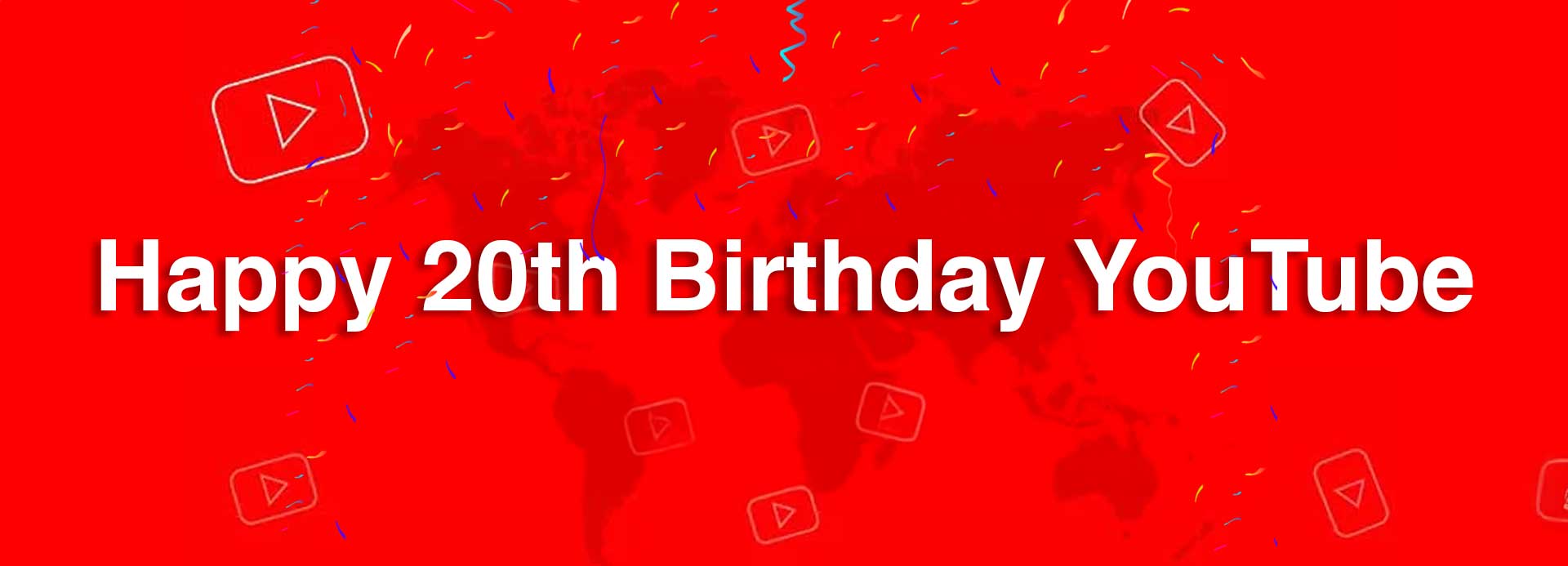

Happy 20th Birthday YouTube, you might have asked yourself, how big is YouTube, really? It’s not just a platform for watching videos it has evolved into a global hub
YouTube Turns 20: A Journey of Growth and Impact
It’s hard to believe that YouTube, one of the most influential and widely used platforms in the world today, has just turned 20. Over the past two decades, YouTube has not only transformed the digital landscape but also reshaped how we consume content, interact with others, and even perceive fame and success. What started as a small platform for uploading personal videos has now evolved into a global phenomenon that hosts billions of hours of content and attracts millions of creators and viewers every single day.
The Origins of YouTube
Let’s rewind to the year 2005 when YouTube was first conceived. The platform was created by three former PayPal employees: Steve Chen, Chad Hurley, and Jawed Karim. The idea came about after they struggled to share video footage from a dinner party, which they couldn’t easily upload to the internet at the time.
They saw an opportunity to create an easy-to-use video-sharing platform that would allow users to upload, share, and watch videos freely. The name “YouTube” was inspired by the words “you” and “tube” (a reference to the television), signifying the platform’s focus on user-generated content and the idea that anyone could be a content creator.
In February 2005, YouTube officially launched, and just a few months later, the first video, “Me at the Zoo,” was uploaded by Jawed Karim. This 18-second video, filmed by Karim himself at the San Diego Zoo, became the first piece of video content on the platform and remains on YouTube to this day. Little did they know that this humble beginning would spark the creation of a digital empire.
The Google Acquisition
While YouTube’s growth was rapid, it was still in its early days, and it faced the same challenges that many tech startups encounter: scaling its infrastructure, monetizing the platform, and maintaining user interest. In 2006, just over a year after its launch, YouTube was purchased by Google for $1.65 billion in stock. At the time, this was a massive acquisition for a platform that was still in its infancy, but Google saw the potential.
Google had already become the dominant search engine at that point, but they recognized that video content was becoming more and more crucial to the internet experience. By acquiring YouTube, Google was positioning itself to lead the charge in the growing video market. This acquisition set the stage for YouTube’s rise to become the second-largest search engine in the world, only behind Google itself.
Every single minute, more than 500 hours of video are uploaded to YouTube. This equates to over 30,000 hours of video being uploaded every hour! It’s no wonder YouTube has such an enormous library of content.
In the years following the acquisition, YouTube rapidly expanded its user base, introduced new features, and made significant improvements to its infrastructure. It wasn’t long before YouTube became the go-to platform for people looking to upload and watch videos across a variety of categories: music, comedy, education, vlogging, gaming, and beyond.
The Rise of Content Creators and YouTube Stars
One of the most remarkable aspects of YouTube’s growth has been the rise of content creators—individuals who, through their videos, have gained massive followings and turned their channels into profitable businesses. Before YouTube, creating a career out of making videos was nearly impossible. Television networks and film studios controlled the distribution of video content, and the idea of becoming famous for creating content online was unheard of. But YouTube changed all that.
In the early days, YouTube was populated with casual videos of people sharing personal experiences or funny moments, but it quickly attracted more ambitious creators who saw the platform as a place to build an audience and share their expertise. People who started off filming in their bedrooms or garages soon turned into global celebrities with millions of subscribers.
Some of the earliest YouTube stars include the likes of Michelle Phan, who began posting beauty tutorials, and PewDiePie, who originally made a name for himself by playing and commenting on video games.
Both of them grew their channels to millions of subscribers, paving the way for the many creators who followed.
But YouTube’s impact on fame wasn’t limited to individuals. The platform also transformed the entertainment industry. Traditional media outlets began to take notice of YouTube’s influence, and many television shows, musicians, and celebrities began using the platform to engage with their audiences. Today, YouTube is a go-to source for interviews, behind-the-scenes footage, music videos, and more.
The Most Famous YouTubers and Their Success
Today, YouTube is home to some of the biggest names in entertainment and online content creation. When we talk about the most famous YouTubers, one name that always comes up is MrBeast (Jimmy Donaldson). He is arguably the most successful YouTuber of the past decade, with over 230 million subscribers across all his channels. Known for his elaborate challenges, philanthropy, and high-budget videos, MrBeast has earned billions of views, and his influence stretches far beyond YouTube itself.
In 2023 alone, MrBeast earned a reported $82 million, making him the highest-paid YouTuber that year. His content, which includes extreme stunts, large-scale challenges, and giving away massive amounts of money, appeals to a wide audience. MrBeast’s success has turned him into a global brand, and he’s even ventured into the world of business, including launching his own burger chain, MrBeast Burger, and a snack company, Feastables.
Another household name in the YouTube community is PewDiePie (Felix Kjellberg), who became famous for his video game commentary and “Let’s Play” videos. Although his rise to fame began in the early 2010s, PewDiePie has maintained a loyal following and remains one of the most influential YouTubers today.
At one point, he held the title of the most-subscribed YouTuber, a title he eventually lost to T-Series, an Indian music channel. Despite the competition, PewDiePie’s impact on YouTube and the world of online content creation is undeniable.
And let’s not forget the countless other creators who have found fame and fortune on the platform. Beauty influencers like James Charles and NikkieTutorials, family vloggers like the Ace Family, tech reviewers like Marques Brownlee, and DIY channels like 5-Minute Crafts—all of these creators have amassed millions of followers and turned their YouTube channels into profitable businesses.
The Most-Liked Videos on YouTube
When it comes to popularity on YouTube, one of the most interesting statistics is the number of likes a video receives. Over the years, certain videos have garnered incredible amounts of engagement, with millions of people clicking that thumbs-up button to show their appreciation.
As of today, the most-liked video on YouTube is “Despacito,” the Latin music video by Luis Fonsi featuring Daddy Yankee. Released in 2017, the video has over 50 million likes and has become a cultural phenomenon.
The song’s catchy beat and infectious lyrics made it an instant hit, and its YouTube video quickly became the most-viewed video on the platform, holding that title for several years.
Another video that holds a record for likes is “Shape of You” by Ed Sheeran, with over 40 million likes. The music video for this chart-topping song has accumulated over 6 billion views, making it one of the most-watched videos on YouTube.
The Most Viewed Video on YouTube
Speaking of views, the title of the most-viewed video on YouTube belongs to the infectious “Baby Shark Dance” by Pinkfong. This simple, catchy children’s song surpassed the previous record-holder, “Despacito,” with over 14.5 billion views.
While “Baby Shark” was initially popular with young children, it has become a global sensation and is frequently played at birthday parties, daycare centers, and in various public spaces.
YouTube’s massive library of content ensures that there’s something for everyone. The platform has become a hub for all kinds of videos, ranging from educational content and tutorials to entertainment, music, news, and much more. It’s also a place where viral trends and challenges spread like wildfire, often leading to real-world phenomena and inspiring people to create their content.
YouTube in Numbers (2025)
As of 2025, YouTube continues to grow at an exponential rate, both in terms of users and the amount of content uploaded. YouTube now boasts over 2.7 billion monthly active users (compared to 2024, 2.49 billion), making it one of the most visited websites in the world. More than 500 hours of video are uploaded to YouTube every minute, which means that in just a single day, there are over 720,000 hours of new content available for users to watch.
On average, YouTube users watch over 1 billion hours of content daily. The platform’s influence is massive, with videos ranging from educational tutorials to music videos and everything in between. YouTube’s algorithm, designed to recommend videos based on individual user preferences, keeps users engaged for hours.
In terms of monetization, YouTube generates billions of dollars in ad revenue each year, and its creators earn a significant portion of this revenue through the YouTube Partner Program. Many content creators have turned their YouTube channels into full-time businesses, leveraging brand deals, merchandise sales, and sponsorships to further monetize their content.
YouTube’s Future
Looking ahead, YouTube’s future seems incredibly bright. As the platform continues to evolve, it’s likely we’ll see even more creators emerge and more content categories take off. Live streaming, in particular, has seen significant growth in recent years, with platforms like YouTube Gaming and YouTube Live becoming increasingly popular. The rise of virtual reality (VR) and augmented reality (AR) could also have a significant impact on the platform, opening new possibilities for content creation and consumption.
As YouTube celebrates its 20th anniversary, it’s clear that the platform has had an immense impact on the digital world, reshaping the way we communicate, entertain ourselves, and even make a living. From its humble beginnings to its current status as the go-to platform for video content, YouTube has forever changed the media landscape, and it’s exciting to imagine where it will go in the next 20 years.
Here’s an infographic from Global Media Insights, outlining YouTube’s overall user statistics, mobile usage, and demographics to help you make an informed decision.

YouTube Statistics 2025
According to research by the GMI Team, over 2.7 billion people worldwide use YouTube each month.
As of July 2024, India has the largest YouTube audience, with approximately 476 million users (Statista).
YouTube is technically the second-largest search engine, following Google.
Over 122 million people access YouTube daily through its website and mobile apps.
The Digital 2024 Global Overview Report reveals that YouTube’s potential ad reach is 2.49 billion users.
In Q1 2024, YouTube generated $8.1 billion in global ad revenue.
As of February 2025, MrBeast holds the record for the most subscribers, with 334 million.
YouTube Premium and YouTube Music combined have over 100 million subscribers worldwide.
YouTube ranks as the second most popular social media platform, after Facebook.
Every day, users watch over a billion hours of video content and generate billions of views.
Demographics & Usage
- 54.4% of YouTube users are male, while 45.6% are female.
- The majority of users fall in the 25-34 age group.
- 63% of YouTube watch time comes from mobile devices.
- Music, entertainment, and educational content are the most-watched genres.
- In 2020, Apple Inc. was YouTube’s biggest advertiser, spending $237.15 million.
- YouTube accounts for 25% of global mobile traffic.
- 74% of adults in the U.S. use YouTube, making it the most popular online platform in the country.
- 80% of U.S. parents with children under 11 years old say their kids watch YouTube videos.
- 16.4% of YouTube traffic comes from the U.S., 9.2% from India, and 4.8% from Japan.
- The average user visits nearly nine pages per day on YouTube.
- The average daily time spent on YouTube is 19 minutes.
- In 2020, viewers watched 100 billion hours of gaming content.
- 72% of people used YouTube for fitness content in 2020.
- YouTube is the top platform for B2B research, used by 50.9% of decision-makers.
Content & Platform Insights
- YouTube hosts over 113.9 million active channels.
- There are more than 100 localized YouTube versions in over 80 languages.
- Of the top 100 searches, 20% are related to music.
- 6% of Google’s ad revenue comes from YouTube.
- YouTube Shorts generate over 70 billion daily views as of 2023.
- The average YouTube Shorts video is 15 seconds long.
- YouTube is the second most popular platform for influencer marketing.
- The most-used languages on YouTube are English and Spanish.
- As of Q3 2020, 62% of U.S. YouTube users accessed the platform daily.
Fun YouTube Facts
- The first-ever YouTube video, “Me at the Zoo,” was uploaded on April 23, 2005.
- YouTube is the second-most visited website globally.
- In 2023, YouTube introduced 30-second unskippable ads on TVs.
- 720,000 hours of new video content is uploaded daily.
- Jimmy Donaldson (MrBeast) was the highest-earning YouTuber in 2023, making $54 million.
- In December 2023, YouTube saw 98 billion mobile visits and 8 billion desktop visits.
- 94.1% of UAE’s population uses YouTube—the highest penetration rate worldwide.
- YouTube users watch over 1 billion hours of content on TVs daily.
- Social Blade estimates there are around 65.3 million YouTube creators.

![YouTube Statistics 2024 [Infographic] hero-image-YouTube-User-Statistics-2024](https://www.skillzme.com/wp-content/uploads/2024/11/hero-image-YouTube-User-Statistics-2024-200x200.jpg)
![Human Wonders Space Travel - Your Next Holiday Destination? [Infographic] hero-image-space-travel](https://www.skillzme.com/wp-content/uploads/2025/01/hero-image-space-travel-200x200.jpg)
![The Evolution of James Bond [Infographic] The Evolution of James Bond](https://www.skillzme.com/wp-content/uploads/2025/02/hero-image-The-Evolution-of-James-Bond-200x200.jpg)


Recent Comments